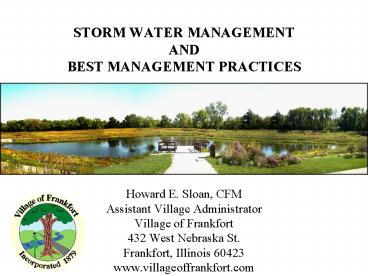STORM WATER MANAGEMENT AND BEST MANAGEMENT PRACTICES - PowerPoint PPT Presentation
1 / 43
Title:
STORM WATER MANAGEMENT AND BEST MANAGEMENT PRACTICES
Description:
Pre-1960's Storm Water Management consisted of dams and levees ... 1990 EPA promulgates NPDES storm water program ... Safety ledge for wet bottom: 10' average width ... – PowerPoint PPT presentation
Number of Views:164
Avg rating:3.0/5.0
Title: STORM WATER MANAGEMENT AND BEST MANAGEMENT PRACTICES
1
STORM WATER MANAGEMENT AND BEST MANAGEMENT
PRACTICES
- Howard E. Sloan, CFM
- Assistant Village Administrator
- Village of Frankfort
- 432 West Nebraska St.
- Frankfort, Illinois 60423
- www.villageoffrankfort.com
2
Location Map
3
In the Beginning
- Pre-1960s Storm Water Management consisted of
dams and levees - USEPA drafts first storm water model in 1969
- 1973 Clean Water Act passes Congress
- 1990 EPA promulgates NPDES storm water program
- 2000 National menu for storm water BMPs released
4
National Menu of Storm Water Best Management
Practices
- Public Education BMP for MS4s to inform
individuals and households - Public Involvement Involve public in BMPs
- Illicit Discharge Detection Elimination BMP
to identify and eliminate discharge and spills to
storm system - Construction BMPs for construction sites to
address storm water runoff - Post-construction BMPs for developers and
property owners to address storm water runoff - Pollution Prevention/Good Housekeeping MS4s to
address BMPs for own facilities
5
Frankforts Storm Water History
- June 24, 1994 216 drainage complaints
- December 1994 first comprehensive storm water
ordinance - March 5, 1997 Storm Water Management Plan
- 2000 Water Resource Management Plan
6
Water Resource Management Plan
- Holistic (BMP) Approach to Storm Water Runoff
- Identification of Receiving Areas
- Streams and Creeks
- Major Drainage Ditches
- Wetlands
- Special Flood Hazard Areas
- Storm Water Management Facilities
- Watershed Management
- Environmental and Ecological Function
- Hydrologic and Hydraulic Function
- Preservation of Natural Landscape
7
(No Transcript)
8
Purpose of Plan
- Recognition of Importance of Natural and Native
Areas - Environmental Assessment of Property
- Incorporation of Environmentally Sensitive Areas
in Land Use Plan - Allow Development with No Adverse Impact
- Assure Proper Maintenance of Areas
- Identification of Village Ordinances and
Regulations
9
Storm Water Management in Frankfort
- Required by all development, regardless of size
- Strict design requirements
- Each project must incorporate conservation design
elements BMP - All work outside of SFHA
- Maintain existing wetlands and depression areas
- Provide groundwater recharge elements
- Dedicate management area as open space
10
USEPA 3-Key BMP Performance Indicators
- Reduce Concentration of Pollutants Leaving BMP
(mg/l) - Reduction in Storm Water Volume
- Total Load Removal
11
USEPA Fact SheetOnStorm Water
ManagementProperly installed and maintained
retention structures (also known as wet ponds)
and artificial wetlands can achieve a high
removal rate of sediment, biochemical oxygen
demand (BOD), organic nutrientsand are most cost
effective when used to control runoff
12
Wet Basin Design is Preferred
- Reduction of Pollutants/Contaminants
- Improves Water Quality
- Retention, extended detention, infiltration and
evapotranspiration - Aesthetics
- Creates Recreational Use Passive Active
13
Center for Watershed Protectionwww.cwp.orgEffect
iveness of Wet Basin inReducing
Pollutants/Nutrients
- Total Suspended Solids (TSS) 50 to
91Total Phosphorus (TP) 30 to
76Total Nitrogen (TN) 19 to
32
14
Wet Basin Design BMP Elements
- Depth below NWL i.e. wet bottom vs. wetland
- Shoreline slopes
- Basin bounce NWL vs. HWL (5 max)
- Draw down times 72 hours max. (10-year event),
USEPA 12-48 hours - Inlet and outlet orientation maximize separation
15
Wet Basin Design BMP Elements (Continued)
- Energy Dissipation at basin inlets outlets
- Safety ledge for wet bottom 10 average width
- Permanent pool volume equal to 2-year event from
watershed - Stilling/Sediment basins min. 500 cf/ac of
impervious surface for drainage area - Vegetated buffer strip
- Wet basin design by qualified designer/ecologist
16
Naturalized Landscaping BMP
- Definition Ecologically sensitive landscaping
that uses regional native plant species to
create, improve or restore specialized and
self-sustaining plant communities for identified
areas i.e. wet basins, wetlands, prairie,
woodland, etc.
17
Naturalized Landscaping BMP
- Landscape plan required for all new storm water
management areas - Landscape plan and plant selection must consider
hydrograph for basin - Short term (3-5 years) and Long term (5 years)
maintenance included in plan - Letter-of-Credit (115 of value) required
- Monitoring Reports required near term annually
and long term every 5-years - Prohibit activity in naturalized area dumping,
alterations, structures, chemical applications
(other than for maintenance)
18
Old Days of Storm Water Management
19
New Day has DawnedWet Basin Storm Water
Management Facilities
20
(No Transcript)
21
(No Transcript)
22
(No Transcript)
23
(No Transcript)
24
(No Transcript)
25
(No Transcript)
26
(No Transcript)
27
(No Transcript)
28
(No Transcript)
29
Shoreline Issues
30
Old Solution
31
BMP Solution
32
Inlet Outlet Issues
33
There are Alternatives
34
And these
35
I like this approach!
36
Energy Dissipation
37
Maximize Separation
38
Siltation SedimentationIts a Problem
39
Here are BMP Solutions
40
Buffer Protection
41
Buffer Suggestions
42
Summary
- Storm Water Ordinance include BMP
- Holistic Approach Evaluate watershed
- No Adverse Impact by development
- Storm Water Management BMP require a plan
- Wet Basin Preferred
- Incorporate naturalized/native plant material
- Enforcement
43
Conclusion
- Village of Frankfort
- Water Resource Management Plan
- Engineering Design Standards
- Landscape Ordinance
- Flood Regulation
- www.villageoffrankfort.com
- - Document Library
- - Browse
- - Map/Ordinance































